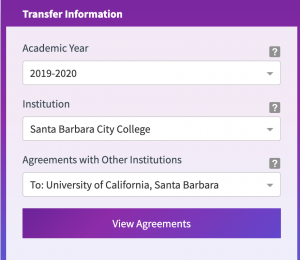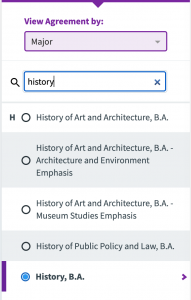This page offers academic advising resources for new and continuing transfer students in the history department.
Online Orientation Module
The history department has worked hard to create a very robust online orientation module for incoming transfer students. If you have not yet done so, please visit the UCSB Orientation Programs Website to access this module. As a new transfer student, you will have access to this module for your entire first year at UCSB!

Transfer Student FAQs:
Where can I find in-depth explanations of my major or minor requirements?
You can find these on our website, on the Change of Major page.
I’m not sure how my history courses from my previous institution will transfer over to UCSB. What should I do?
If you attended a California Community College before transferring to UCSB, you can view your course equivalencies on assist.org. Here are step-by-step instructions for how to find history course articulations:
- In the “Transfer Information” box, select the academic year in which you took the history course at your CC. It is very important to select the correct year (i.e. fall 2016, spring 2018, etc.) because articulations can change from year to year. Then, select the community college you attended under “Institution”, and UCSB from the “Agreements with Other Institutions” drop-down menu. Click the “View Agreements” button at the bottom.

- Under the “View Agreement By” menu at the top of the page, select “Major”. Type your major into the search bar below, and select it when it populates. Then, click the blue “View Agreement” button that appears to the right.

- Review the articulation PDF that appears. The courses in the right hand column are the community college classes, and the courses in the left hand column are their UCSB equivalencies. If you have any questions about how to read the articulation agreements, please contact the history Undergraduate Advisor. *Please note that many of the history sequence courses taken at a semester-system community college will transfer from 2 courses at CC to 3 courses at UCSB. For example, if you completed HIST 101 and 102 at SBCC, you have already earned credit for the entire HIST 17A/B/C series at UCSB. If you have questions about this, or if your credit appears wrong in your progress check, contact your undergraduate major advisor.

If you attended another four year institution or an out-of-state community college before transferring to UCSB, you will need to petition your transfer courses for major credit with the history department. Please submit the syllabi for any history courses you have taken through our online petition form (if you no longer have the syllabus, please reach out to your former professor/advisor for help obtaining it). The history department will then review your courses, and determine any equivalencies.
I have questions about my non-history courses, GEs, or my IGETC. Where do I go?
Any academic advising questions not directly related to your major requirements can be answered by advisors in the Transfer Student Center.
What is Duplicate Matriculation, and how do I avoid it?
Although duplicate matriculation is rare and there are several ways to avoid it, it most commonly happens among transfer students. Duplicate matriculation occurs when you take a course at UCSB for which you have already earned credit at your CC. You will not receive any credit for taking the course a second time (units or grade wise) so this should always be avoided. Let’s say for example that you took the equivalent of History 8: Intro to Latin American History at your community college before transferring to UCSB. You didn’t check assist.org or reach out to your history department advisor before signing up for classes, and you forgot that you had already taken an intro to Latin American history course at your community college. Even if you complete the entire course and receive a grade for it, if you have already taken an equivalent course in the past, all credit for the second offering will be taken away. Here are some ways to safeguard yourself from duplicate matriculation:
- If you attended a California Community College, check assist.org for your course equivalencies.
- If your new student profile or your progress check are available in GOLD, check them to see if you already have credit for any history courses.
- If you attended another four year institution or an out-of-state community college before transferring to UCSB OR if you still have questions, contact the history Undergraduate Advisor.
It is also important to note that all community college coursework is considered lower division, so you cannot have duplicate matriculation with upper division courses if you attended a community college before transferring to UCSB.
How can I tell the difference between upper and lower division courses?
Lower division courses always have a number between 1-99, and upper division courses are numbered 100-199.
I need to take an upper division research seminar to complete my major requirements. When should I take it?
History 9: Historical Investigations, Methods and Skills is now required for all transfer students who matriculated in Summer 2020 and on. This lower division research course is meant to prepare you for the required upper division research seminar, and should ideally be taken first. History 9 is currently offered in every quarter except for summer, and fills up extremely fast. The history department highly recommends enrolling in (or waitlisting) this course during your first pass time to ensure a spot. This course is the only major-restricted class in the history department, so only History and History of Public Policy and Law majors will be able to enroll in it during the first pass time. The history department also highly recommends not taking the upper division research seminar during your first quarter at UCSB.
I want to apply for the Senior Honors Thesis program at the end of my first year. Where can I find more information on the requirements?
Please see our website page for details on the Senior Honors Thesis application process. Students apply to this program at the end of their junior year, so you will need to fulfill all the application requirements by the spring quarter of your first year. This course takes places every fall and winter quarter.
